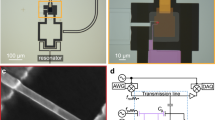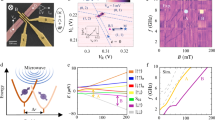Abstract
Controlling decoherence is the biggest challenge in efforts to develop quantum information hardware1,2,3. Single electron spins in gallium arsenide are a leading candidate among implementations of solid-state quantum bits, but their strong coupling to nuclear spins produces high decoherence rates4,5,6. Group IV semiconductors, on the other hand, have relatively low nuclear spin densities, making them an attractive platform for spin quantum bits. However, device fabrication remains a challenge, particularly with respect to the control of materials and interfaces7. Here, we demonstrate state preparation, pulsed gate control and charge-sensing spin readout of hole spins confined in a Ge–Si core–shell nanowire. With fast gating, we measure T1 spin relaxation times of up to 0.6 ms in coupled quantum dots at zero magnetic field. Relaxation time increases as the magnetic field is reduced, which is consistent with a spin–orbit mechanism that is usually masked by hyperfine contributions.
This is a preview of subscription content, access via your institution
Access options
Subscribe to this journal
Receive 12 print issues and online access
$259.00 per year
only $21.58 per issue
Buy this article
- Purchase on Springer Link
- Instant access to full article PDF
Prices may be subject to local taxes which are calculated during checkout




Similar content being viewed by others
References
Loss, D. & DiVincenzo, D. P. Quantum computation with quantum dots. Phys. Rev. A 57, 120–126 (1998).
Hanson, R. & Awschalom, D. Coherent manipulation of single spins in semiconductors. Nature 453, 1043–1049 (2008).
Petta, J. R., Lu, H. & Gossard, A. C. A coherent beam splitter for electronic spin states. Science 327, 669–672 (2010).
Khaetskii, A. V., Loss, D. & Glazman, L. Electron spin decoherence in quantum dots due to interaction with nuclei. Phys. Rev. Lett. 88, 186802 (2002).
Johnson, A. et al. Triplet–singlet spin relaxation via nuclei in a double quantum dot. Nature 435, 925–928 (2005).
Petta, J. et al. Coherent manipulation of coupled electron spins in semiconductor quantum dots. Science 309, 2180–2184 (2005).
Dyakonov, M. I. (ed.) Spin Physics in Semiconductors (Springer Series in Solid-State Sciences 157, Springer, 2008).
Elzerman, J. M. et al. Single-shot read-out of an individual electron spin in a quantum dot. Nature 430, 431–435 (2004).
Koppens, F., Buizert, C., Tielrooij, K. & Vink, I. Driven coherent oscillations of a single electron spin in a quantum dot. Nature 442, 766–771 (2006).
Nowack, K., Koppens, F. & Nazarov, Y. Coherent control of a single electron spin with electric fields. Science 318, 1430–1433 (2007).
Bluhm, H. et al. Dephasing time of GaAs electron–spin qubits coupled to a nuclear bath exceeding 200 µs. Nature Phys. 7, 109–113 (2011).
Foletti, S., Bluhm, H., Mahalu, D., Umansky, V. & Yacoby, A. Universal quantum control of two-electron spin quantum bits using dynamic nuclear polarization. Nature Phys. 5, 903–908 (2009).
Trauzettel, B., Bulaev, D. V., Loss, D. & Burkard, G. Spin qubits in graphene quantum dots. Nature Phys. 3, 192–196 (2007).
Kloeffel, C., Trif, M. & Loss, D. Strong spin–orbit interaction and helical hole states in Ge/Si nanowires. Phys. Rev. B 84, 195314 (2011).
Mason, N., Biercuk, M. & Marcus, C. Local gate control of a carbon nanotube double quantum dot. Science 303, 655–658 (2004).
Hu, Y. et al. A Ge/Si heterostructure nanowire-based double quantum dot with integrated charge sensor. Nature Nanotech. 2, 622–625 (2007).
Steele, G. A., Gotz, G. & Kouwenhoven, L. P. Tunable few-electron double quantum dots and Klein tunnelling in ultraclean carbon nanotubes. Nature Nanotech. 4, 363–367 (2009).
Shaji, N. et al. Spin blockade and lifetime-enhanced transport in a few-electron Si/SiGe double quantum dot. Nature Phys. 4, 540–544 (2008).
Katsaros, G. et al. Hybrid superconductor–semiconductor devices made from self-assembled SiGe nanocrystals on silicon. Nature Nanotech. 5, 458–464 (2010).
Zwanenburg, F. A., van Rijmenam, C., Fang, Y., Lieber, C. M. & Kouwenhoven, L. P. Spin states of the first four holes in a silicon nanowire quantum dot. Nano Lett. 9, 1071–1079 (2009).
Xiao, M., House, M. G. & Jiang, H. W. Measurement of the spin relaxation time of single electrons in a silicon metal-oxide–semiconductor-based quantum dot. Phys. Rev. Lett. 104, 096801 (2010).
Simmons, C. B. et al. Tunable spin loading and T1 of a silicon spin qubit measured by single-shot readout. Phys. Rev. Lett. 106, 156804 (2011).
Hayes, R. R. et al. Lifetime measurements T1 of electron spins in Si/SiGe quantum dots. Preprint at arXiv:0908.0173v1 (2009).
Borselli, M. G. et al. Pauli spin blockade in undoped Si/SiGe two-electron quantum dots. Appl. Phys. Lett. 99, 063109 (2011).
Hanson, R., Petta, J. R., Tarucha, S. & Vandersypen, L. M. K. Spins in few-electron quantum dots. Rev. Mod. Phys. 79, 1217–1265 (2007).
Lieber, C. & Wang, Z. Functional nanowires. MRS Bull. 32, 99–108 (2007).
Lu, W., Xiang, J., Timko, B., Wu, Y. & Lieber, C. One-dimensional hole gas in germanium/silicon nanowire heterostructures. Proc. Natl Acad. Sci. USA 102, 10046–10051 (2005).
Zulicke, U. & Csontos, D. Zeeman splitting in cylindrical hole quantum wires. Curr. Appl. Phys. 8, 237–240 (2008).
Nenashev, A. V., Dvurechenskii, A. V. & Zinovieva, A. F. Wave functions and g factor of holes in Ge/Si quantum dots. Phys. Rev. B 67, 205301 (2003).
Zhong, Z. H., Fang, Y., Lu, W. & Lieber, C. M. Coherent single charge transport in molecular-scale silicon nanowires. Nano Lett. 5, 1143–1146 (2005).
Roddaro, S. et al. Spin states of holes in Ge/Si nanowire quantum dots. Phys. Rev. Lett. 101, 186802 (2008).
Wang, L., Shen, K., Sun, B. Y. & Wu, M. W. Singlet–triplet relaxation in multivalley silicon single quantum dots. Phys. Rev. B 81, 235326 (2010).
Trif, M., Simon, P. & Loss, D. Relaxation of hole spins in quantum dots via two-phonon processes. Phys. Rev. Lett. 103, 106601 (2009).
Levitov, L. S. & Rashba, E. I. Dynamical spin–electric coupling in a quantum dot. Phys. Rev. B 67, 115324 (2003).
Shankar, S., Tyryshkin, A., He, J. & Lyon, S. Spin relaxation and coherence times for electrons at the Si/SiO2 interface. Phys. Rev. B 82, 195323 (2010).
Winkler, R. in Spin–Orbit Coupling Effects in Two-Dimensional Electron and Hole Systems Ch. 3, 28 (Springer Tracts in Modern Physics 191, Springer, 2003).
Hao, X. J. et al. Strong and tunable spin–orbit coupling of one-dimensional holes in Ge/Si core/shell nanowires. Nano Lett. 10, 2956–2960 (2010).
Nadj-Perge, S., Frolov, S. M., Bakkers, E. P. A. M. & Kouwenhoven, L. P. Spin–orbit qubit in a semiconductor nanowire. Nature 468, 1084–1087 (2010).
Tang, J-M., Levy, J. & Flatté, M. E. All-electrical control of single ion spins in a semiconductor. Phys. Rev. Lett. 97, 106803 (2006).
Acknowledgements
The authors thank H. Churchill, J. Medford and E. Rashba for technical help and discussions, and acknowledge support from the DARPA/QuEST programme.
Author information
Authors and Affiliations
Contributions
Y.H. and F.K. performed the experiments. Y.H. prepared the materials and fabricated the devices. Y.H., F.K., C.M.L. and C.M.M. analysed the data and co-wrote the paper. All authors discussed the results and commented on the manuscript.
Corresponding authors
Ethics declarations
Competing interests
The authors declare no competing financial interests.
Rights and permissions
About this article
Cite this article
Hu, Y., Kuemmeth, F., Lieber, C. et al. Hole spin relaxation in Ge–Si core–shell nanowire qubits. Nature Nanotech 7, 47–50 (2012). https://doi.org/10.1038/nnano.2011.234
Received:
Accepted:
Published:
Issue Date:
DOI: https://doi.org/10.1038/nnano.2011.234
This article is cited by
-
Hole-type superconducting gatemon qubit based on Ge/Si core/shell nanowires
npj Quantum Information (2023)
-
The functions of a reservoir offset voltage applied to physically defined p-channel Si quantum dots
Scientific Reports (2022)
-
Ultrafast coherent control of a hole spin qubit in a germanium quantum dot
Nature Communications (2022)
-
Integration of boron arsenide cooling substrates into gallium nitride devices
Nature Electronics (2021)
-
Ultrafast hole spin qubit with gate-tunable spin–orbit switch functionality
Nature Nanotechnology (2021)



